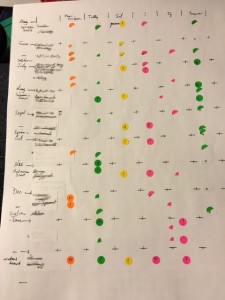Last time, I discussed some thoughts on cues and audience expectation.
Today, I want to look at an example where the cueing was poorly done, and resulted in disappointment for at least some audience members.
My target is Wing Commander.
When I saw this recently, it caught my eye as having a few instances of poor cueing — some of which made a difference, and some of which didn’t.
I am going to look at three examples of failed cueing in the movie. One is the innocuous sort of false cue that is almost inevitable in a complex work. The other two are more problematic.
Example 1: Minor cueing failure
When the MC and his best friend first arrive at their posting, they go and check out the fighters they’ll be flying. Almost immediately they see an attractive female — the first, as far as I can recall.
Rob made a crack about her clearly being the love interest, an opinion that I was inclined to agree with.
Of course, then we met the real love interest some twenty seconds later.
Cue Cause: Something unusual (a girl!), underscored by character attention.
Effect: Brief red herring about the love interest. A minor red herring that did not cause any disappointment when it turned out to be misleading.
Comments: This cueing misfire didn’t really hurt anything, although it didn’t really accomplish anything, either. If there is a good variety of characters all the way through, the storyline will be less vulnerable to such mis-cues, because the first girl (or POC or …) won’t stand out as different from the homogenous norm.
Example 2: Detail-based cueing failure
One of the major sources of tension through the middle of the movie is the MC’s Pilgrim association (he is half Pilgrim, which makes him the subject of suspicion by some of the crew members). Early on, he discusses his Pilgrim memento — an amulet roughly in the shape of a cross — with his best friend. His friend thinks he should get rid of it.
All well and good.
But then it is revealed that it has a little knife that can pop out of it.
It is a striking and suggestive detail.
We promptly decided that it would play a key role in the plot, probably in some sort of fight.
It . . . didn’t.
The amulet crops up again, but the little knife isn’t shown ever again. It doesn’t play a role, major or minor.
We were disappointed.
Cue Cause: something unusual (the amulet has a knife!), underscored by character attention, the fact that it had clear utility, and the fact that it was otherwise pointless.
Effect: this engendered the expectation that the knife would show up later and be used for something cool. The lack thereof caused disappointment.
Comment: this detail registered as a cue rather than an enriching detail because it was unusual, it was not surrounded by other details of similar weight, and it was a detail that had clear application. The reason all of this is problematic is that the viewer is cheerfully waiting for the knife to come into play, and when it doesn’t, is disappointed. It’s sort of like putting a gun on the mantle, but never having it fired or used to hit someone over the head.
Example 3: Interaction-based cueing failure
The MC’s best friend does some semi-competitive showing off with a girl.
The girl subsequently dies in an accident as a result of showing off.
The MC’s love interest blames the best friend.
All well and good.
But then there is a scene where the MC tells his love interest (who is also a officer) that she needs to make things right with the MC’s best friend, because she needs every fighter at her disposal.
This cued the expectation that the best friend would then play an important and likely redeeming role.
But . . . that was basically the last we saw of him.
Cue Cause: an emotionally fraught scene where the MC’s love interest forgives the best friend because they’re about to go into battle.
Effect: this engendered the expectation that the MC’s best friend would play some sort of important or cool role, or — failing that — die spectacularly. It is somewhat ironic, because he did play an important role — but it was before the “clearing the air” scene with the MC’s love interest.
The issue with this is similar to the issue with the unused dagger: there was the expectation that something interesting would happen at the end, and it didn’t happen. With a really good climax that might not have been a problem, but Wing Commander had a relatively weak climax — so the cues relating to interesting things that never happened were far more noticeable.
Comment: if you’re going to make a big deal of needing someone, their success or failure should be important. They should somehow be relevant, whether they come through or not.
To just ignore the whole thing doesn’t hack it.
In this case, I think they were just tying off the sub-plot “hey, we can’t just leave the MC’s love interest mad at the MC’s best friend,” but it looked like it should relate back to the main plot. And it didn’t.
General thoughts:
The two cueing failures that I consider problematic set up expectations for an exciting climax and resolution.
The ending turned out to be pretty lukewarm, so the cues stuck in my mind as missed opportunities.
I see two possible fixes:
1. Pay attention to the critical cues, and fulfill or subvert them.
2. Have such a splendid, satisfying climax that it blows away any recollection of what the audience expected.




